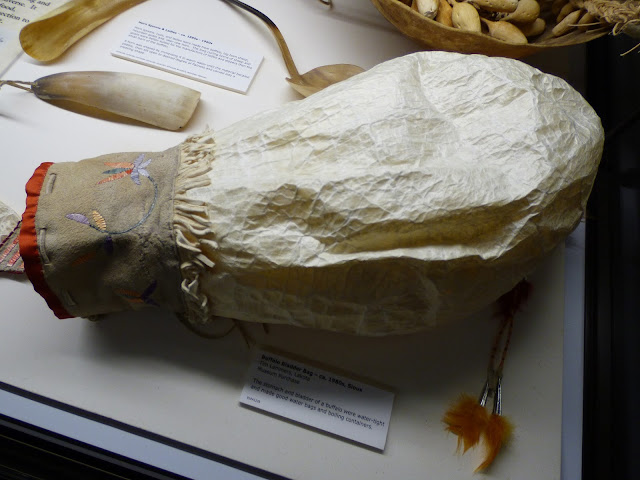We had an unusual start today as we all pulled out of the campground following each other to the Akta Lakota Museum
on the campus of St. Joseph's Indian School in Chamberlain, SD just under four miles away. We parked along a circular drive on the edge of the Missouri River and walked over to the museum for a tour before setting off for our next destination.
The Akta Lacota Indians were part of the larger group called Plains Indians that lived through out what we now refer to as the Plains states. They were nomads who depended on the buffalo heavily for their food, tools, clothing, housing, and just about everything else. Every part of the buffalo was used for something - this display board just begins to touch on some of the items
One of the items that intrigued me was the use of the bladder. It and the stomach were both used as a cooking pot as well as a container to hold water as they were water tight.
Even some of the kids games were made from bones and hide. All of the games were developed to help the children gain excellent hand eye coordination, gain skills in swiftness and prepare them for everyday life. (in this case it was deer bones)
The girls made dolls, their clothes, teepees, etc. learning all of the skills necessary for womanhood when they would be the owners of and in charge of creating, putting up and taking down the teepees, making all of the clothing, cooking, and rendering the buffalo once it is killed into all of its various parts so it could be fully used.
The boys by the time they were six were already accompanying their fathers on nearby hunts and doing small chores in the camps. Grandparents did much of the everyday child care.
In the above picture you'll notice the miniature leaning chair on the left. This was apparently their "Lazy Boy". Two adult sized ones were set up for people to try if they wished though none of us had the agility the Indians did to get down and really enjoy it.
They used paints made out of various flowers to decorate their clothing and blankets often telling a story in their designs. Bones were used to paint withLovely boxes and envelopes made out of hide carried their belongings.
Between a film and the displays we were able to get a real good feel for their way of life. It was amazing to hear that a woman could get a teepee put up in ten minutes with the assistance of another woman and take it down in three minutes. Since they were often on the move this would have been a necessary skill I guess.
The clothing as we all know from pictures was decorative first with paints, shells, hair and bones and then when trading began lots of tiny beads.
Even the horses had decorative wear for special occasions
The popular headdresses were made up of eagle's feathers attached to a leather bonnet - each feather signifying a courageous deed. The goal was 36 feathers - equal to 3 eagles worth of tail feathers.
The rain was coming down hard when we finished at the museum so our drives had to begin with very damp bodies in the seats. The winds were quite strong as well so the drive itself was not what had been hoped. It followed the Missouri River to Ft. Pierre first traveling two lane roads through plains with only an occasional home to be seen but horses and other animals were spotted along the way. Then the plains began to become hills and by the time we finished we were at a higher elevation still very near the Missouri River. In fact the name of this campground is Oahe Downstream as it is near the Oahe Dam.
I don't think the temperature ever got any higher than 55 but the winds did die down as did the rain and by evening we were getting patches of sunshine. Hopefully a sign of a good day tomorrow.



















No comments:
Post a Comment